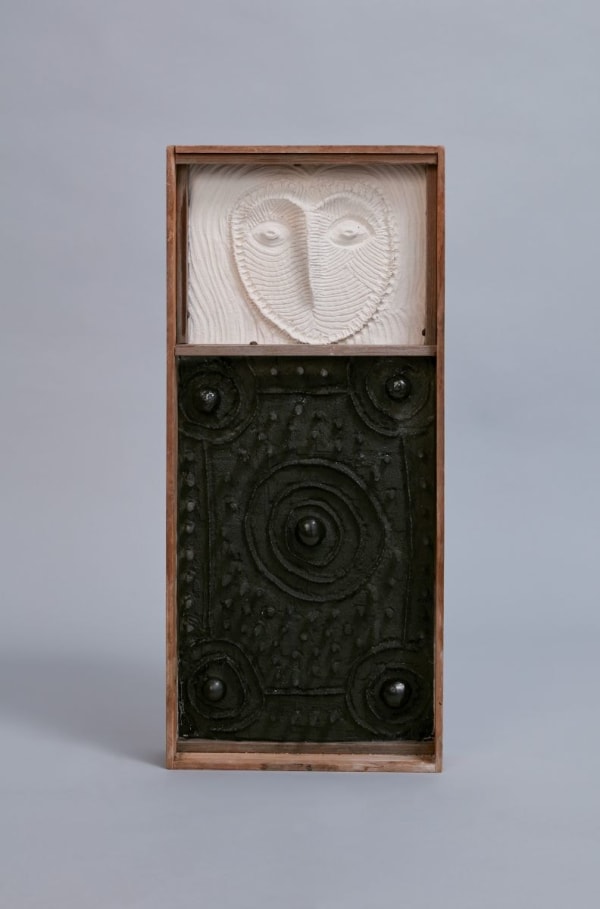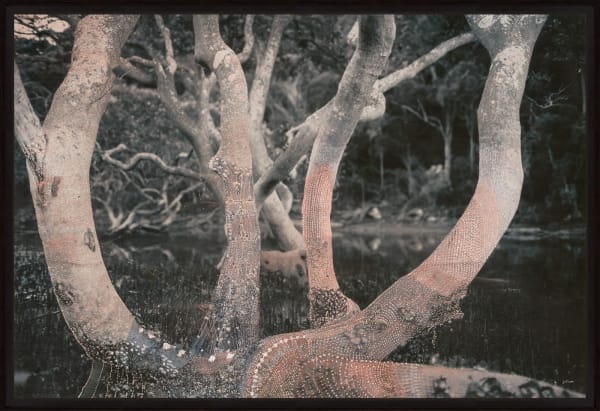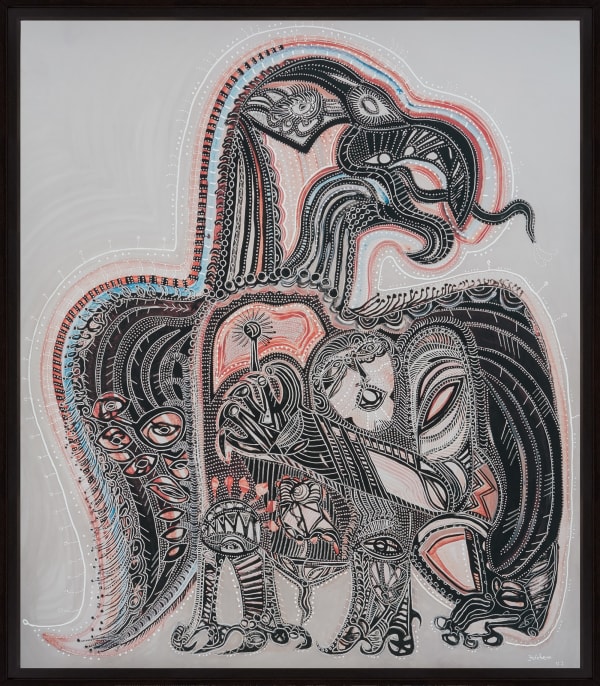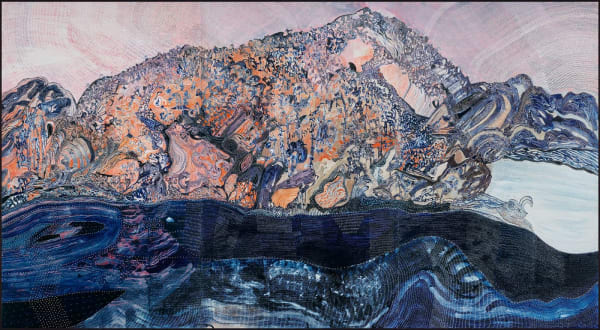Joshua Yeldham: Hearthstone
-
 Joshua YeldhamCloud Owl, 2021ceramic & cane40 x 22 x 22 cm
Joshua YeldhamCloud Owl, 2021ceramic & cane40 x 22 x 22 cm -
 Joshua YeldhamCosmos Owl (box), 2021ceramic, wood & stone68 x 31 x 8 cm
Joshua YeldhamCosmos Owl (box), 2021ceramic, wood & stone68 x 31 x 8 cm -
 Joshua YeldhamDiviner Owl, 2021acrylic, shell & cane on hand-carved board122 x 91 cm
Joshua YeldhamDiviner Owl, 2021acrylic, shell & cane on hand-carved board122 x 91 cm -
 Joshua YeldhamEclipse Owl, 2021ceramic & stone40 x 20 x 20 cm
Joshua YeldhamEclipse Owl, 2021ceramic & stone40 x 20 x 20 cm -
 Joshua YeldhamFan Girl, 2017acrylic, cane, antique fans & instrument on hand-carved board182 x 122 cm
Joshua YeldhamFan Girl, 2017acrylic, cane, antique fans & instrument on hand-carved board182 x 122 cm -
 Joshua YeldhamGhost Owl, 2021acrylic & stone64 cm
Joshua YeldhamGhost Owl, 2021acrylic & stone64 cm -
 Joshua YeldhamHealing Bay Smiths Creek, 2021acrylic and can on hand - carved board152 x 203 cm, 154.5 x 205.5 cm (framed)
Joshua YeldhamHealing Bay Smiths Creek, 2021acrylic and can on hand - carved board152 x 203 cm, 154.5 x 205.5 cm (framed) -
 Joshua YeldhamHearthstone I, 2021ceramic, wood & stone70 x 22 x 15 cmSold
Joshua YeldhamHearthstone I, 2021ceramic, wood & stone70 x 22 x 15 cmSold -
 Joshua YeldhamHearthstone Owl Spirit II, 2021ceramic50 x 148 x 18 cm
Joshua YeldhamHearthstone Owl Spirit II, 2021ceramic50 x 148 x 18 cm -
 Joshua YeldhamHearthstone Owl Spirit III, 2021ceramic & cane48 x 11 x 11 cmSold
Joshua YeldhamHearthstone Owl Spirit III, 2021ceramic & cane48 x 11 x 11 cmSold -
 Joshua YeldhamHearthstone VI, 2021ceramic34 x 13 x 13 cm
Joshua YeldhamHearthstone VI, 2021ceramic34 x 13 x 13 cm -
 Joshua YeldhamInfinity Owl, 2021acrylic, stone & cane47 cm
Joshua YeldhamInfinity Owl, 2021acrylic, stone & cane47 cm -
 Joshua YeldhamLittle Lion Owl, 2021ceramic & cane28 x 23 x 23 cm
Joshua YeldhamLittle Lion Owl, 2021ceramic & cane28 x 23 x 23 cm -
 Joshua YeldhamLittle Owl of Pleasure, 2021ceramic & cane32 x 30 x 30 cm
Joshua YeldhamLittle Owl of Pleasure, 2021ceramic & cane32 x 30 x 30 cm -
 Joshua YeldhamMangrove Owl, 2021acrylic, ceramic, wood & cane51 cm
Joshua YeldhamMangrove Owl, 2021acrylic, ceramic, wood & cane51 cm -
 Joshua YeldhamMangrove Web, 2021acrylic on unique hand-carved pigment print on cotton paper130 x 192 cm
Joshua YeldhamMangrove Web, 2021acrylic on unique hand-carved pigment print on cotton paper130 x 192 cm -
 Joshua YeldhamMother Owl – Smiths Creek, 2021acrylic & cane on hand-carved board199 x 244 cm
Joshua YeldhamMother Owl – Smiths Creek, 2021acrylic & cane on hand-carved board199 x 244 cm -
 Joshua YeldhamOwl Dwelling, 2021ceramic & cane30 x 9 x 9 cm
Joshua YeldhamOwl Dwelling, 2021ceramic & cane30 x 9 x 9 cm -
 Joshua YeldhamOwl of Blue Waterhole, 2021unique hand-carved pigment print160 x 120 cm, 180 x 139 cm (framed)Edition of 35 plus 2 artist's proofs
Joshua YeldhamOwl of Blue Waterhole, 2021unique hand-carved pigment print160 x 120 cm, 180 x 139 cm (framed)Edition of 35 plus 2 artist's proofs -
 Joshua YeldhamOwl of the Sea, 2021ceramic21 x 7 x 7 cm
Joshua YeldhamOwl of the Sea, 2021ceramic21 x 7 x 7 cm -
 Joshua YeldhamProtection From White Noise (no. 1 in a series of 9), 2021unique hand-carved pigment print with copper wire & cane on Dibond124 x 249 cm
Joshua YeldhamProtection From White Noise (no. 1 in a series of 9), 2021unique hand-carved pigment print with copper wire & cane on Dibond124 x 249 cm -
 Joshua YeldhamProtector of Arrows, 2021acrylic on hand-carved linen paper200 x 202 cm
Joshua YeldhamProtector of Arrows, 2021acrylic on hand-carved linen paper200 x 202 cm -
 Joshua YeldhamRed Taro Owl, 2021acrylic, cane & instrument on hand-carved board203 x 152 cm
Joshua YeldhamRed Taro Owl, 2021acrylic, cane & instrument on hand-carved board203 x 152 cm -
 Joshua YeldhamRiver Diviners, 2021acrylic, cane & instrument on hand-carved board214 x 122 cm
Joshua YeldhamRiver Diviners, 2021acrylic, cane & instrument on hand-carved board214 x 122 cm -
 Joshua YeldhamRiver Owls, 2021stone & wood180 x 52 x 26 cm
Joshua YeldhamRiver Owls, 2021stone & wood180 x 52 x 26 cm -
 Joshua YeldhamSea Eagle of Protection, 2021unique hand-carved pigment print121 x 105 cm, 141 x 124 cm (framed)Edition of 35
Joshua YeldhamSea Eagle of Protection, 2021unique hand-carved pigment print121 x 105 cm, 141 x 124 cm (framed)Edition of 35 -
 Joshua YeldhamSilver Owl XI, 2021resin & cane on hand-carved aluminium56 x 40 x 40 cm
Joshua YeldhamSilver Owl XI, 2021resin & cane on hand-carved aluminium56 x 40 x 40 cm -
 Joshua YeldhamSmiths Creek, 2021acrylic & cane on hand-carved board199 x 366 cm
Joshua YeldhamSmiths Creek, 2021acrylic & cane on hand-carved board199 x 366 cm -
 Joshua YeldhamSnake Charmer, 2021acrylic on hand-carved linen paper200 x 202 cm
Joshua YeldhamSnake Charmer, 2021acrylic on hand-carved linen paper200 x 202 cm -
 Joshua YeldhamSnow Owl Offering, 2021brass, wood, stone & acrylic on carved board89 x 34 x 33 cm
Joshua YeldhamSnow Owl Offering, 2021brass, wood, stone & acrylic on carved board89 x 34 x 33 cm -
 Joshua YeldhamSway Owl, 2021acrylic on hand-carved linen paper202 x 200 cm
Joshua YeldhamSway Owl, 2021acrylic on hand-carved linen paper202 x 200 cm -
 Joshua YeldhamThe Stillness – Smiths Creek (no.1 in a series of 9), 2021unique hand-carved pigment print on cotton paper180 x 120 cm
Joshua YeldhamThe Stillness – Smiths Creek (no.1 in a series of 9), 2021unique hand-carved pigment print on cotton paper180 x 120 cm -
 Joshua YeldhamTree Offering – Morning Bay, 2021collage & acrylic on unique hand-carved pigment print on cotton paper130 x 192 cm
Joshua YeldhamTree Offering – Morning Bay, 2021collage & acrylic on unique hand-carved pigment print on cotton paper130 x 192 cm -
 Joshua YeldhamWaterhole at Yeomans Bay, 2021acrylic & cane on hand-carved board203 x 152 cm
Joshua YeldhamWaterhole at Yeomans Bay, 2021acrylic & cane on hand-carved board203 x 152 cm -
 Joshua YeldhamWhite Horse of Smiths Creek, 2021ceramic & hand-carved wood68 x 50 x 8 cm
Joshua YeldhamWhite Horse of Smiths Creek, 2021ceramic & hand-carved wood68 x 50 x 8 cm -
 Joshua YeldhamWhite Owl of Smiths Creek, 2021ceramic48 x 22 x 22 cm
Joshua YeldhamWhite Owl of Smiths Creek, 2021ceramic48 x 22 x 22 cm
Used the way Joshua Yeldham intended, Healing Heart has light and warmth emanating from both its base and centre: the stomach and the chest of its slightly-more-than-human figure. With a candle placed inside, the ceramic work takes on a quality of deep, settled earthliness. A blue perforation at the heart opens like an impossible peony.
This same blue openness – spatial, temporal, and ideational – operates across the hand-carved surface of the painting Smiths Creek. A scene of tidal waft on Gadigal land, the deep field of the creek across the foreground breaks open the durational possibilities of painting. In the mountains pictured behind the water there is narrative time, pressed densely into the open-ended and transcendental forms that we find along the ridges. In the image’s shifting perspective, we experience the duration of the day: water shifts beneath the viewer, allowing our vision a cyclical, tidal foundation. In the rhythm of pattern – in linework, in the belt-sanded vibrations across the sky and the carving through the water – time is energetically charged and laid open.
Yeldham and I speak about the body of work in which these pieces appear one afternoon, during the first Spring storm of the season and with the frightening memories of the 2020 fires still close to hand. This storm seems almost too perfect a setting in which to be having our discussion. Storms like these are both a rupture in the fabric of the day and an occasion for retreat into the safety of hearth and home. It’s along this path precisely – from rupture to return – that many of these recent works bring both Yeldham and his audience.
Yeldham’s carved photographs, like Protection From White Noise, take this idea of return doubly. There is, on one hand, the affective reprieve that the image offers, with its visible open space through the centre of the carved driftwood form. But the reparative work that the image does is as much in its matter and manner as its form. The regenerative carving work on an image of ‘dead’ wood that Yeldham undertakes makes a case for art as a natural component of the earthly promise of renewal to which we are all subject.
Perhaps the most apparent shift that this show represents in the artist's practice though, is a turn towards ceramics, in addition to paintings. In the past two years, Yeldham has added a pottery studio to his home north of Sydney, from which he works, surrounded by Eucalyptus trees and close to Pittwater. In part, this new angle of approach to the natural environment – from below, or even within – was brought about by the disruption to routine that many of us have encountered over the past eighteen months. ‘Many of my works, often, emerge from being on my boat’, says Yeldham, but over the course of Sydney’s sequential lockdowns, ‘I couldn’t get out onto the water. So, I went into the bush and was scaling the sandstone escarpments, fingers in clay’.
In a telling turn of phrase, Yeldham refers to the surrounding landscape in the feminine. I ask him why this is. ‘I suppose sensuality is often connected to she’, he says, ‘and I connect sensuality to landscape as well. [In landscape] my hands are touching bark and I’m feeling my senses enliven…I feel beholden to the experiences that nature gives me. I am removed from a sense of personal power and instead find myself making contact without having to control or to adapt my environment’.
This trajectory from sensorial involvement in one’s surrounds to a feeling of beholden-ness to them is one Yeldham follows across his work. Several of the pieces in this show bear surfaces thickly woven through with cane. Making thousands of small punctures in the hand-carved bases of these pictures allowed a phenomenological immersion, a sustained focus, and a lightening of the self which Yeldham found. ‘It’s drill, cane, cut. Drill cane, cut’, he explains, ‘this practice allowed me to let go of the white noise that can stifle us from making and allowing ourselves to be vibrant and expressive’.
These works are a clear, insistent centre amongst the ‘white noise’ of our public and domestic lives in the twenty-first century, and especially during the dual environmental and public health crises which we’ve weathered here over the past two years. Many of Yeldham’s new works are usable – as vessels for burning candles, or as playable instruments. River Diviners, for example, hold musical instruments in their centres, carved into the board of the painting. The figure on the left side grasps a tree in one hand – a gesture reflecting Yeldham’s experience of ‘weaving [him]self through nature’ to feel centred within the world – and a three-pronged tuning fork in the other. As Yeldham tells me, these three prongs represent a tripartite prayer for protection, guidance and forgiveness. The works across this show, like these three prayers, give us both a place to dwell, amongst all the flotsam of the present, and a means for figuring out how to dwell here, on the hearth that they provide.
Erin McFadyen
Arts Writer & Deputy Editor of Artist Profile









































